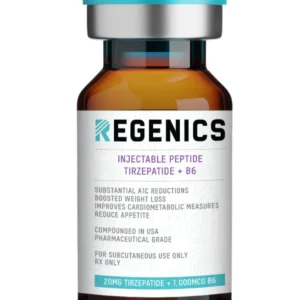What is Zepbound?
Zepbound (tirzepatide) is used for weight loss for adults with obesity or who are overweight and have weight-related medical problems. Zepbound helps you to lose weight and maintain the weight loss and should be combined with diet and exercise. Zepbound works for weight loss by decreasing your appetite and slowing the movement of food from the stomach into the small intestine, which may make you feel full more quickly and for a longer period of time.
Zepbound is a once-weekly injection given under the skin (subcutaneous) using a pre-filled single-dose pen.
Zepbound is a GIP and GLP-1 receptor agonist, so its mechanism of action is it activates both GIP (glucose-dependent insulinotropic polypeptide) and GLP-1 (glucagon-like peptide-1) hormone receptors. Zepbound contains the same active ingredient (tirzepatide) as Mounjaro, and they are both made by Eli Lilly and Company.
Zepbound received FDA approval on November 8, 2023, for chronic weight management in adults with obesity (with a BMI of 30 kg/m2 or greater) or adults who are overweight (with a BMI of 27 kg/m2 or greater) and also have weight-related medical problems such as hypertension, dyslipidemia, type 2 diabetes mellitus, obstructive sleep apnea or cardiovascular disease. Zepbound should be used together with diet and increased physical activity.
What are the side effects of Zepbound?
Common Zepbound side effects
The most common Zepbound side effects include abdominal pain, burping, constipation, diarrhea, dyspepsia, fatigue, gastroesophageal reflux disease, hair loss, hypersensitivity reactions, injection site reactions, nausea, and vomiting which affects 5% or more patients.
Serious Zepbound side effects
Stop using this medicine and get emergency medical help if you have:
- signs of an allergic reaction: hives; difficulty breathing; feeling light-headed; swelling of your face, lips, tongue, or throat; or
- pancreatitis with symptoms of severe pain in your upper stomach spreading to your back, nausea and vomiting.
Call your doctor at once if you have:
- severe stomach problems;
- eye side effects or vision changes, including blurry vision or blurred vision;
- signs of a thyroid tumor symptoms may include swelling or a lump in your neck, trouble swallowing, a hoarse voice, or if you feel short of breath;
- gallbladder problem with symptoms including chalky-colored stools, stomach pain after eating, nausea, heartburn, bloating, and severe upper stomach pain that may spread to your back;
- low blood sugar symptoms may include headache, hunger, weakness, sweating, confusion, irritability, dizziness, fast heart rate, or feeling jittery; or
- kidney problems with little or no urination, swelling in your feet or ankles, feeling tired or short of breath.
This is not a complete list of side effects, and others may occur. Call your doctor for medical advice about side effects. You may report side effects to FDA at 1-800-FDA-1088.
Related/similar drugs
How much weight is lost on Zepbound?
Patients on Zepbound (tirzepatide) 5mg weekly lost 16.1 kg (35.5 lb) on average after 72 weeks. For Zepbound 10mg weekly dose, the average weight loss was 22.2 kg (48.9 lb), and for Zepbound 15mg weekly dose average weight loss was 23.6 kg (52.0 lb) over 72 weeks. Patients who used a placebo lost 2.4 kg (5.3 lb) over the 72 weeks. These results are from the clinical trial SURMOUNT-1, NCT04184622. Individual results may vary. Learn more.
What is the difference between Mounjaro and Zepbound?
Mounjaro and Zepbound are FDA-approved to treat different conditions, Mounjaro is FDA-approved for type 2 diabetes, and Zepbound is FDA-approved to help achieve and maintain weight loss. Mounjaro and Zepbound both contain the same active ingredient, tirzepatide, and are made by Eli Lilly and Company. They are both given as weekly injections under the skin and are available as single-dose pens in the same strengths 2.5 mg, 5 mg, 7.5 mg, 10 mg, 12.5 mg,15 mg per 0.5 mL.
Warning
Call your doctor immediately if you have thyroid tumor symptoms, such as a lump or swelling in your neck, hoarseness, trouble swallowing, or shortness of breath.
In studies with rats, tirzepatide and medicines that work in the same way caused thyroid tumors, including thyroid cancer. It is not known whether Zepbound will cause thyroid tumors or a type of thyroid cancer called medullary thyroid carcinoma (MTC) in people.
You should not use this medicine if you or you have a family history of a type of thyroid cancer called medullary thyroid carcinoma (MTC) or if you have an endocrine system condition called Multiple Endocrine Neoplasia syndrome type 2 (MEN 2).
Keep all appointments with your doctor and the laboratory. Your doctor may order certain tests to check your body’s response to this medicine.
Before using this medicine
You should not use Zepbound if you:
- are allergic to the tirzepatide or any ingredients contained in this medicine; see ingredients at the bottom of this page.
- have a personal or family history of medullary thyroid carcinoma (a type of thyroid cancer); or
- multiple endocrine neoplasia type 2 (tumors in your glands).
Tell your doctor if you have ever had:
- pancreas problems;
- kidney disease;
- a severe stomach problem such as problems with digesting food or slowed emptying of your stomach (gastroparesis); or
- diabetic retinopathy (a diabetes complication that affects the eyes).
Pregnancy
Tell your healthcare provider if you are pregnant, you become pregnant, or plan to become pregnant while using this medicine. It is not known if this medicine will harm your unborn baby.
Tell your doctor if you become pregnant while taking this medicine. There will be a pregnancy exposure registry for women who have taken Zepbound during pregnancy. The purpose of this registry is to collect information about the health of you and your baby. Talk to your healthcare provider about how you can take part in this registry or you may contact Eli Lilly and Company at 1-800-LillyRx (1-800-545-5979).
Zepbound can make birth control pills less effective. Ask your doctor about other birth control options such as an injection, implant, skin patch, vaginal ring, condom, diaphragm, cervical cap, or contraceptive sponge. If you take birth control pills, you may need to use additional birth control methods for 4 weeks after starting this medicine, and for 4 weeks each time, the dose is raised.
Breastfeeding
Tell your healthcare provider if you are breastfeeding or plan to breastfeed while using this medicine. It is not known whether Zepbound passes into your breast milk. Talk to your healthcare provider about the best way to feed your baby while using this medicine.
How should I use Zepbound?
You should follow the directions on your prescription label carefully and ask your pharmacist or doctor to explain any part you do not understand. It is important to use this medicine exactly as directed. Do not take more or less of it or more often than your doctor prescribes.
Zepbound is a pre-filled pen injected under the skin (subcutaneously).
Zepbound is usually given:
- once a week
- can be given with or without meals at any time of the day
- may be injected into the thigh, abdomen, or upper arm
- you should rotate the injection site with each dose
Your doctor will usually start you on a low dose, which will gradually increase, but not more than once every 4 weeks.
You may change the day of the week you use this medicine as long as there is at least three days between doses.
Zepbound Dosing Information
Usual Zepbound Adult Dose for Weight Loss
Initial dose: 2.5 mg under the skin (subcutaneously) once a week.
After 4 weeks: The dosage should be increased to 5 mg subcutaneously once a week.
Further dose increases: After at least 4 weeks on the current dose the dosage may be increased in 2.5 mg increments.
Recommended maintenance dose: 5 mg, 10 mg, or 15 mg injected subcutaneously once weekly.
Maximum dose: 15 mg subcutaneously once a week.
What strength are Zepbound pens available as?
- 2.5 mg/0.5 mL single-dose pen
- 5 mg/0.5 mL single-dose pen
- 7.5 mg/0.5 mL single-dose pen
- 10 mg/0.5 mL single-dose pen
- 12.5 mg/0.5 mL single-dose pen
- 15 mg/0.5 mL single-dose pen.







Reviews
There are no reviews yet.